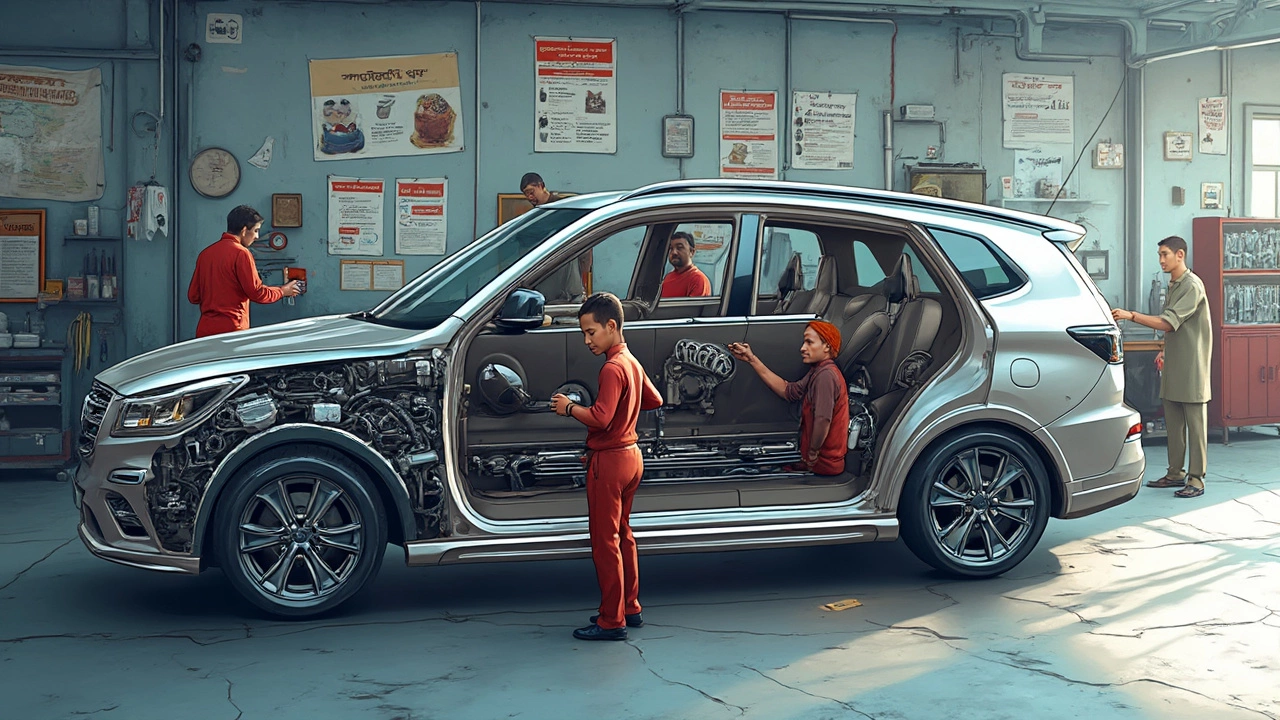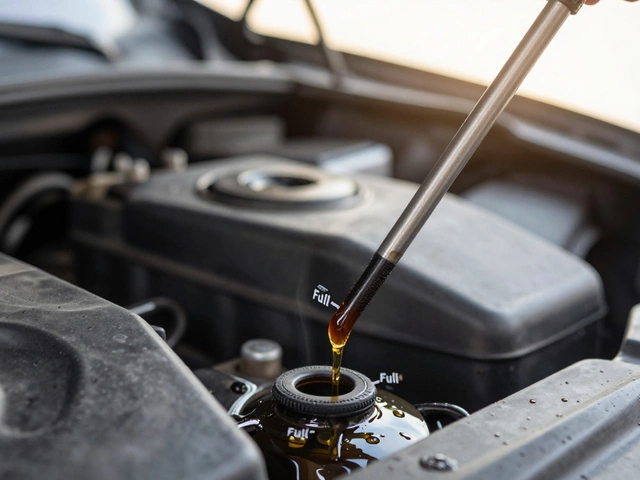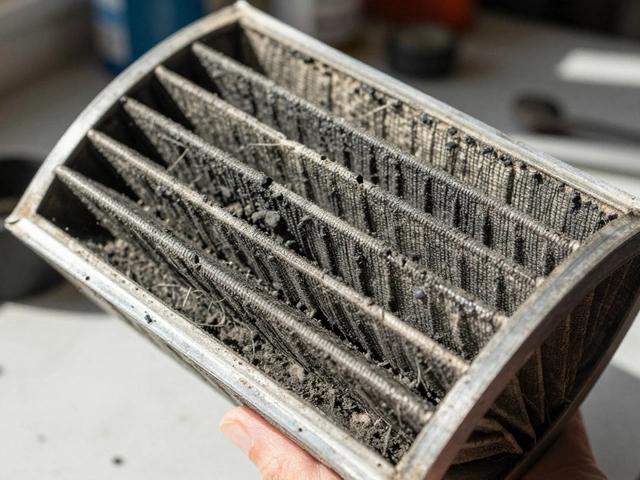
Ever thought a rough ride was just about comfort? Turns out, if your suspension parts aren't doing their job, your engine could pay the price. Every time you hit a pothole or take a speed bump too fast, faulty suspension puts extra stress on all sorts of parts—including the engine mounts and the engine itself.
The connection isn’t obvious at first. But look at it this way: suspension is supposed to absorb shocks and keep everything balanced. When it fails, all that shaking and bouncing ripples through the whole car—including the engine. Joint damage and worn out mounts sneak up over time, making your engine work harder and maybe even shortening its life.
That’s why it’s not just about having a smooth ride. Keeping your suspension healthy can save you money on repairs you never expected, especially those surprise engine problems.
- How Suspension and Engine Work Together
- What Happens When Suspension Fails?
- Signs Your Engine Is Feeling the Strain
- Real-World Examples: Engine Trouble from Bad Suspension
- Maintenance Tips to Protect Both Systems
- When to Replace Suspension Parts
How Suspension and Engine Work Together
If you look under your car, you’ll notice the suspension parts and engine aren’t totally separate systems—they rely on each other to keep the whole thing running smooth. The suspension keeps your car stable and helps the wheels stay in solid contact with the road. That means less vibration and shaking for everything, including your engine.
Manufacturers design engine and transmission mounts to soak up some of these impacts, but they’re not meant to handle all of it. When your suspension parts get worn out, too many shocks and bumps—especially from bad roads—start reaching your engine mounts and even the engine block. Over time, that can make the mounts split or sag, and you’ll often get more noise, vibration, and even leaks or misalignment.
Here’s where things get real: a report from the Society of Automotive Engineers found that “persistent suspension wear increases peak vibration levels to engine mounts by up to 20-30%, accelerating deterioration of engine components.”
"The suspension doesn’t just make rides smoother; it protects the engine from damage caused by uncontrolled chassis movement." – Society of Automotive Engineers
When your car’s ride comfort drops, that’s not just your back complaining—it’s your engine taking hits it wasn’t designed to handle. More vibration can also mess with parts like belts, hoses, and exhaust connections, forcing your engine to work harder. Over time, this can even affect vehicle handling and safety.
So, while you might think of the suspension as just keeping you comfy, it’s actually saving your engine from a lot of unnecessary trouble.
What Happens When Suspension Fails?
When your suspension parts start giving out, things can get bad fast. You’ll notice right away if your car feels extra bouncy, leans way too much when turning, or makes odd noises over bumps. But the bigger issue is what’s going on underneath the surface—every bit of shock and vibration that’s supposed to be handled by the suspension shoots straight through the frame and ends up putting more stress on the engine and other key components.
Here’s what can happen when your suspension stops doing its job:
- Worn engine mounts: Too much vibration can chew through engine mounts fast, leading to shaky rides and potential engine misalignment.
- Drivetrain stress: A saggy suspension can knock wheels out of alignment, making the engine work overtime just to move the car in a straight line.
- Tire wear: You’ll go through tires way quicker, which can also affect how hard your engine works.
- Lower fuel efficiency: The extra resistance from misaligned tires or dragging suspension parts means the engine burns more fuel than normal.
- Possible leaks: All the jolts and bumps can cause fluids to leak out of connections that weren’t made to take that much movement.
To put it in perspective, the American Automobile Association (AAA) found that hitting potholes and driving with bad suspension parts costs drivers over $3 billion every year in the U.S. Just fixing the suspension alone is much cheaper than sorting out engine issues caused by ignoring it.
So if your ride starts to feel off, don’t just turn up the radio and hope for the best. Tackling suspension parts problems early on can save your engine and your wallet down the road.
Signs Your Engine Is Feeling the Strain
Most folks don't connect engine problems with suspension issues, but the signs can be pretty clear if you know what to look for. When the suspension parts start failing, the whole engine bay shakes more than it should. That extra movement stresses engine mounts and other pieces that are meant to hold everything steady. Here’s what you might notice if your engine is working overtime because your suspension’s not right:
- Strange noises: Clunks, knocks, or rattles when you accelerate, brake, or drive over bumps. These sounds usually mean parts are getting jarred around more than they should be.
- Excessive vibration: If your steering wheel or even your whole dashboard shimmies while driving, worn-out suspension can’t dampen movement, so the engine gets shaken too.
- Rough idling: You might feel the engine shaking when stopped at a light. This often points to worn engine mounts, which are stressed by a bouncy suspension.
- Poor handling or pulling to one side: Suspension and vehicle handling issues don’t just chew up tires—they force the engine to fight harder, especially during acceleration.
- Fluid leaks: Increased stress and vibration can crack hoses and gaskets, leading to oil or coolant leaks—never cheap or fun to fix.
A study from the National Highway Traffic Safety Administration showed that vehicles with neglected suspension were 17% more likely to report engine mount failures over ten years compared to those with regular car maintenance. So, it’s not just about the ride comfort—it's your wallet, too.
| Symptom | Possible Cause (Related to Suspension) |
|---|---|
| Engine vibration | Worn mounts from constant jarring |
| Unusual noises | Loose or broken suspension components |
| Poor acceleration | Uneven tire contact due to sagging springs |
If you spot these symptoms early and fix your suspension parts, you’ll save yourself headaches later. Don’t wait until you’re staring at an engine rebuild bill—deal with that rough ride as soon as possible.

Real-World Examples: Engine Trouble from Bad Suspension
If you've ever skipped replacing worn suspension parts, you might not just face a bumpy ride—you could actually be setting your engine up for trouble. It's more common than you think. Take, for example, a 2015 Toyota Camry that started running rough and vibrating like crazy. The culprit? Blown struts. Every bump was transferring stress straight to the engine mounts. Over six months, those mounts cracked, which made the engine shift and led to a leaking oil pan. The owner ended up having to replace both the mounts and pay for engine repairs.
Another case involved a 2018 Ford F-150. After ignoring clunky noises from the front suspension for about a year, the driver noticed a drop in acceleration and a lot more noise from under the hood. Mechanics found that the uneven handling caused by sagging springs was tilting the engine ever so slightly, causing misalignment in the driveshaft. The long-term result? Premature wear on critical engine components and the transmission.
| Vehicle Model | Suspension Issue | Engine/Related Damage |
|---|---|---|
| 2015 Toyota Camry | Blown Struts | Cracked Engine Mounts, Oil Leak |
| 2018 Ford F-150 | Sagging Springs | Driveshaft Misalignment, Engine Wear |
| 2017 Honda CR-V | Broken Control Arm | Engine Vibration, Transmission Strain |
It’s not just older cars, either. A newer Honda CR-V had a broken control arm and within a few months, the driver noticed the engine was rattling way more than usual. The bad suspension was making the whole setup unstable, adding wear to both the engine and gearbox. The mechanic said the issue would've cost hundreds less if caught earlier.
If your car is vibrating more, making clunky sounds, or just doesn't feel right after going over rough roads, it's not just about ride comfort. Ignoring those early suspension warnings can end up costing way more in engine repairs than just swapping out those aging parts. A simple check on your vehicle handling and suspension can save your wallet—and your engine—from a world of hassle.
Maintenance Tips to Protect Both Systems
Taking care of your suspension parts doesn’t just keep rides smooth—it seriously helps your engine and your wallet. A solid suspension system means less shake and rattle, which means less wear on engine mounts and other critical parts. Regular checks and smart habits can make a big difference.
Here are the basics you don’t want to skip:
- Inspect shock absorbers and struts: Every 12,000 miles (or at least once a year), look for leaks, dents, or rust. Worn shocks don’t absorb bumps and send vibrations straight to the engine.
- Check engine mounts: When doing suspension work, peek at engine mounts. If you see cracks or worn rubber, it’s time to swap them out. Weak mounts make your engine shake more when the suspension isn’t doing its job.
- Listen and feel: Unusual noises when you drive over bumps or sudden jolts could mean trouble. Don’t ignore clunks or rattles—they’re often warning signs that link right back to both your engine and suspension parts.
- Keep tires balanced and aligned: Bad alignment stresses your suspension and the drivetrain, which can sneakily add pressure on the engine. Rotating and aligning tires twice a year is smart.
- Don’t overload your car: Heavy loads compress your suspension more, and the extra work can strain the engine, too. Stick to the weight limit in your car’s manual.
- Use quality parts: Cheap bushings and mounts wear out fast and can cause more headaches than they’re worth. Spend a bit more upfront, avoid big bills later.
If you’re into the numbers, here’s how much maintenance (or a lack of it) can matter:
| Maintenance Task | How Often | Potential Engine Impact |
|---|---|---|
| Shock/Strut Check | 12,000 miles | Limits engine vibration transfer |
| Engine Mount Inspection | Every 30,000 miles | Prevents extra engine movement |
| Tire Rotation & Alignment | Every 6 months | Keeps engine load balanced |
Regular small checks now beat big repair bills later. Stay on top of vehicle handling by keeping your suspension parts and engine in sync—your future self will thank you.
When to Replace Suspension Parts
Bad suspension parts can creep up on you, but there are clear signs it’s time for a swap. Don’t wait for a total breakdown, because by the time your ride feels like a roller coaster, your engine and other car maintenance costs might start shooting up too. Most shocks and struts should be checked at least every 50,000 miles, but that’s just a ballpark—your driving style and local roads can speed things up.
- Uneven tire wear: If the treads look lopsided or you’re replacing tires way too often, your suspension isn’t keeping things level.
- Keeps bouncing: Push down on the hood—if your car doesn’t settle after one bounce, those shocks are toast.
- Clunky noises: Knocks or rattles over bumps mean something’s loose or worn out, and ignoring it can trash not just your suspension, but also expensive engine parts.
- Steering issues: If your wheel pulls to one side, especially after hitting a pothole, something’s bent or busted down below.
- Fluid leaks: Leaky struts or shocks are easy to spot—look for oily residue around the wheel wells.
Here’s a quick look at how common suspension parts stack up for replacement timing:
| Part | Typical Replacement Interval |
|---|---|
| Shocks/Struts | 50,000 - 100,000 miles |
| Ball Joints | 70,000 - 150,000 miles |
| Bushings | 60,000 - 100,000 miles |
| Tie Rods | 50,000 - 100,000 miles |
If you’re doing vehicle handling or ride comfort checks and things feel off, don’t wait. Letting worn suspension hang around just hits your wallet harder later—especially if it leads to surprise engine issues.





